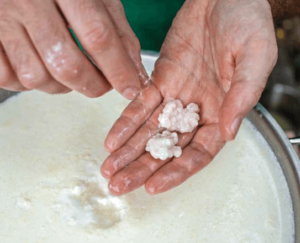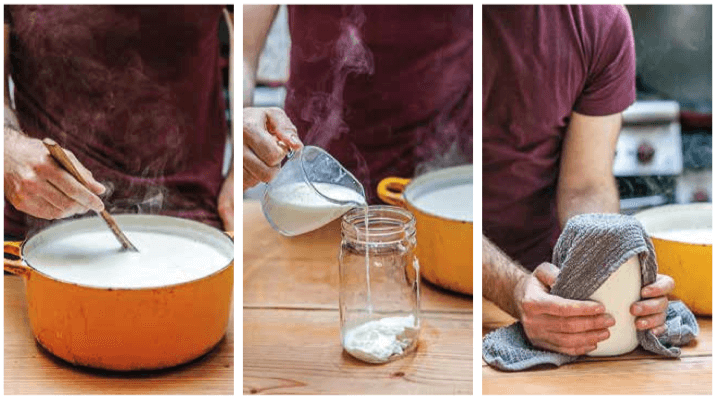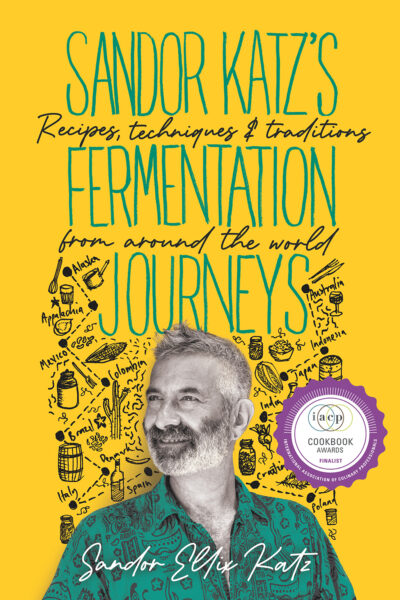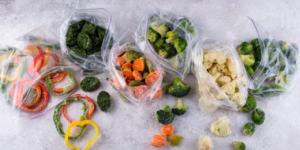Natural Yogurt: Using Kefir As A Yogurt Starter
Yogurt making is having a moment. See what all the fun is about by making your own natural yogurt! This recipe uses kefir as a starter for an end result that is guaranteed to delight your taste buds.
The following excerpt is from The Art of Natural Cheesemaking by David Asher. It has been adapted for the web.
(Photography courtesy of Kelly Brown unless otherwise noted.)
It TakesYogurt to Make Yogurt
In the process of yogurt making, milk is first cooked; once it’s cooled, a small amount of yogurt starter culture is added to the cooked milk, and the inoculated milk is then incubated at a warm temperature until the yogurt sets.
But though most yogurt makers source their yogurt starter either from packages of freeze-dried yogurt culture or with a bit of yogurt saved from a previous batch of yogurt-making, I make yogurt with kefir.
Kefir culture is a diverse source of many beneficial cheesemaking cultures and can serve as a starter for making any kind of cheese. Conveniently, active kefir grains rise to the top of warm milk and can be easily removed from the curd once it has set.
And though it may be an unconventional approach to yogurt-making (is there a recipe in this book that isn’t unconventional?), using kefir as a yogurt starter works.
Cooking Milk for Yogurt
That’s because it’s the cooking of milk prior to culturing, followed by a high-temperature culturing period, that transforms milk to yogurt, and not any specific culture that is added to the milk.
Cooking the milk achieves several ends: First, it concentrates the milk, which results in a thicker curd as the yogurt ferments.
Second, it denatures the albumin proteins in the milk into the curd, which also thickens the yogurt; and third, the high-temperature cooking and subsequent incubation reduces the oxygen in the milk, which encourages the appropriate types of fermentation that give yogurt its best qualities.
Making Yogurt With Kefir
Making yogurt with kefir, the high-temperature incubation encourages the development of Lactobacillus and Streptococcus bacteria, both endemic to kefir and both responsible for giving yogurt good flavor and texture.
The low-oxygen conditions encouraged by the high-temperature incubation of the fermenting milk reduce the activity of kefir’s yeast and fungal cultures, thus eliminating any effervescence that would normally develop.
The Texture of Yogurt
In the struggle to attain the perfect yogurt curd, many yogurt makers pull out all the stops. Some believe that the only way to get a good thick yogurt is to add powdered milk or milk protein concentrates, which, unfortunately, can have questionable origins.
Others invest in expensive and unnecessary yogurt-making machines. Many replace their yogurt starter cultures frequently, especially those who use DVI yogurts, whose lab-raised bacteria are sensitive to contamination if reused.
However, I’ve found that given that the milk is unprocessed, and the cultures are healthy and active, getting the right texture in yogurt is all about following the proper technique— specifically paying attention to the milk as it is cooked and incubated.
How to Achieve the Perfect Texture
For yogurt to develop its best texture, its making demands the maker’s full attention. The milk should be cooked slowly to a high enough temperature— 185°F (85°C)—and for a long period of time, at least half an hour.
The milk must be stirred nonstop as it is cooked, to encourage evaporation but also to ensure that it does not scorch on the bottom or form a skin on the top, both of which are coagulations of milk solids that take away from the thickness of the yogurt.
What to Do After Cooking
After cooking, you must cool the milk to the appropriate incubation temperature, stirring all the while to prevent a skin from forming.
The cooled milk is inoculated with starter culture (the less you add, the better the result!), then the inoculated milk is incubated in a warm place to ensure it remains in the range of temperature at which yogurt sets best—between 100 and 110°F (that’s 38 to 43°C).
Once the milk has thickened, it has finished its transformation into yogurt and can be placed in the refrigerator to halt its fermentation, or left to ferment longer if you’re looking for a more acidic yogurt.
Advantages to Using Kefir
I’ve found excellent results when carefully following this technique when using traditional yogurt cultures (many of which can be found in yogurt-making communities or from natural culture companies like Cultures for Health), or kefir.
The advantages to using kefir as a yogurt starter, however, are that you need not bother keeping any other starters (something that deterred me from making yogurt with specific yogurt cultures)…and the diversity of microorganisms within the culture make a remarkably flavorful yogurt.
Furthermore, if the kefir is prepared with raw milk, the result will be a true raw milk yogurt.
RECIPE: Natural Yogurt
Equipment
- 1-gallon pot for cooking your milk (use either a heavy-bottomed pot or a double boiler to keep the milk from scorching as it cooks)
- 3 (1-quart or 1-L) Mason jars Improvised incubator
Time Frame: 1–2 hours of preparation; 4–8 hours of incubation
Yield: Makes about 3 quarts (3 L) of yogurt
Ingredients
- 1 gallon (4 L) whole-fat milk, pasteurized or raw, preferably unhomogenized
- 3⁄4 cup (180 mL) active kefir (strained kefir grains), prepared the day before, or yogurt
Procedure
To make yogurt, cook milk stirring all the while; add kefir or yogurt culture to the milk once it has cooled, and keep the milk warm until it sets.
- Slowly warm the milk to 185°F (85°C) over medium heat. Stir the milk as it warms.
- Cook the milk at 185°F for 30 minutes to 1 hour. Stir it nonstop. The longer the milk is cooked, the thicker the yogurt will be.
- Cool the milk to 110°F (43°C): Take the pot of milk off the heat, and stir it until the temperature falls to that point. Don’t have a thermometer? An age-old method of judging the perfect yogurt incubation temperature is to submerge your finger in the milk—if you have to pull it out in pain after 10 seconds, the temperature is just right!
- Add the yogurt culture to the milk: Add 1⁄4 cup (60 mL) of kefir or yogurt to each jar, then add an equal amount of the cooked milk, and mix the two.
- Fill the jars with the remaining milk, and put a lid on them.
- Incubate at 100–110°F (39–43°C) for 4 to 12 hours, keeping the jars in a warm spot, such as an insulated cooler filled with warm water, or a warm oven with the light on.
- After 4 hours, watch the jars for visible signs of setting. Once the curd has set, your yogurt is ready though if left to ferment longer, it can develop its tanginess. Kept refrigerated, it will last a couple of weeks.
Recommended Reads
Recent Articles
Cheese is milk’s destiny. Be inspired by the celebration of milk-in all its forms-especially the transformation of milk into cheese through natural cheesemaking
Read MoreTry your hand at preserving veggies by freezing them! Freezing vegetables is a quick, simple way to preserve them for winter meals.
Read MoreThe possibilities are pretty much endless with wild ingredients — use almost any fresh fruit or juice and a sweetener to create your own custom jam or syrup!
Read MoreDid you know that more than just the seeds of a sunflower are edible? Almost every part of a sunflower are completely safe and delicious when cooked correctly.
Read More












